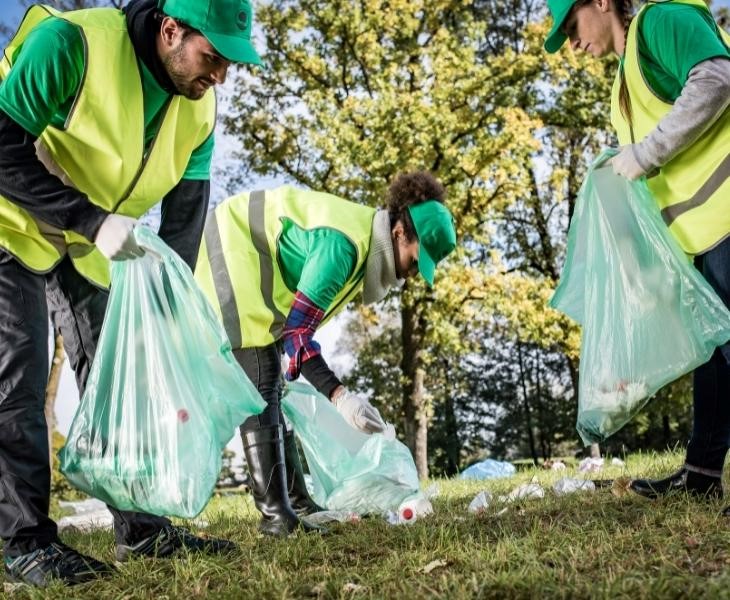Every year, countless tons of trash end up in our waterways, posing a significant threat to marine life. Cleanup Australia Day is coming up soon and is the ideal opportunity for us all to help our communities and the environment by clearing rubbish from landfills, waterways, and the ocean.
Clean Up Australia Day is more than just a cleanup event; it’s a vital initiative to protect our oceans and wildlife. On Clean Up Australia Day, volunteers around the world unite to remove litter from beaches, rivers, and oceans. Whether you’re a school, a business, or an individual, the day offers opportunities for everyone to get involved and make a positive impact.
As a business, you can do your bit for the environment by organising a clean-up event with the help of your employees to highlight the importance of reducing waste. Here are some quick safety guidelines to help you organise and plan a safe and productive cleanup day, without incident.
1. Choose an Appropriate Time and Location
The first step in organising a clean-up is deciding on a location, date, and time. Picking up waste in a public space will always involve some risk, however by carefully selecting the location you can avoid potential hazards and reduce the likelihood of injury. Avoid high-risk areas, such as those near high-speed zones, busy roads, watercourses, or where there has been a build-up of hazardous materials, such as harmful chemicals, car batteries, or syringes.
2. Conduct a Risk Assessment
Conducting a risk assessment once you’ve found a suitable location for your clean-up event will ensure the suitability of the site and help you determine any controls that need to be incorporated. Map out any potential risks that can come from traffic, neighbourhood, landscape, nature, or man-made infrastructure like pipelines or power grids. Depending on your findings, you can then decide on appropriate controls, rules, or equipment to be used on the day to eliminate or reduce the possibility of hazards occurring.
3. Keep a First Aid Kit Handy
Bringing along a properly stocked first aid kit will give you peace of mind in the event of a medical emergency. Keep your first aid kit in a safe, dry, and easily accessible place, and ensure that everyone in your team is aware of its location. Keep a basic first aid manual or instruction booklet in the first aid kit. Make sure to check the kit to see if anything is missing, low on supplies, or has expired.
4. Weather Safety
Stay up to date with the local weather forecast and prepare beforehand for any mishaps. If the weather forecast predicts extreme conditions (such as storms, heavy rain, wind, snow, or extreme heat), consider whether it is safe to continue with the clean-up.
- In the event of high temperatures, make sure your volunteers stay hydrated, apply sunscreen, and wear sunglasses, long-sleeved shirts, and hats to avoid sunburn or heatstroke.
- If the weather is cold, wet, or windy make sure the volunteers are dressed in warm and dry clothing. Slips, trips, and falls can happen easily in wet or icy weather conditions. Be cautious while walking on wet pavements or in grassy areas.
- Poor visibility can increase the risk associated with collecting waste, so you should consider the best time of day for your event to take place.
Always be aware of your surroundings and any wildlife that may be present in areas where you’re planning to hold your clean-up.
5. Maintain Safety and Hygiene
Proper sanitation and hygiene can help lower the risk of illness and infection.
- Make sure you have enough hygiene supplies, such as hand sanitiser, disinfectant, face masks, or hand soap.
- Cover cuts or grazes with surgical tape or waterproof plasters
- Volunteers should be advised to wash and sanitise their hands after handling rubbish and before and after eating/drinking.
6. Protective Clothing and Equipment
Have volunteers wear reflective hi-visibility vests or light-coloured clothing to draw the attention of traffic, pedestrians, and cyclists. To reduce the possibility of slips/falls/trips, make sure they are wearing sturdy boots or shoes with good grip. Supply disposable gloves to protect their hands from potentially hazardous materials like broken glass, syringes, chemicals, faeces, or any drug-related waste.
7. Lifting and Handling Heavy Objects
Lifting or handling heavy objects can result in severe injuries. Make sure that volunteers know to leave larger or heavier waste items so that appropriate arrangements can be made for their safe removal.
- Encourage volunteers to stretch and warm up before beginning the clean-up to help reduce muscle strain.
- Give them reachers and grabbers to eliminate the need for constant bending and stretching, as well as the risk of hand injury from contact with sharp objects.
- To avoid cuts, place glasses and other sharp objects in sturdy containers rather instead of plastic bags.
- Bend your legs and keep your back straight while lifting something heavy. Remember to only lift or move something if it can be done without strain.

